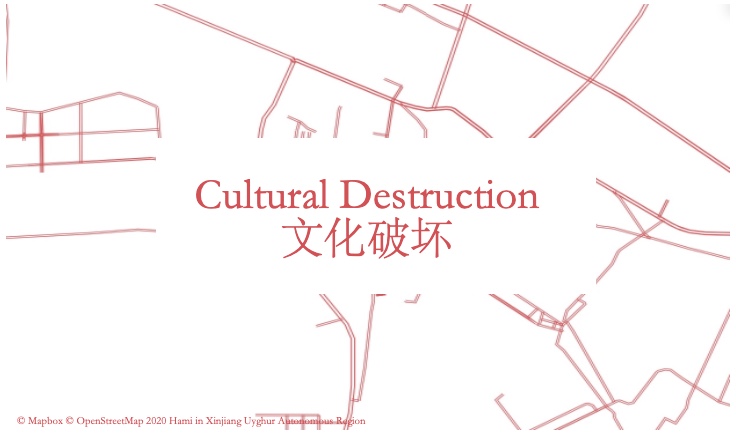
Introduction
This timeline outlines state efforts to regulate religious and cultural expression in Xinjiang. With justifications ranging from deradicalization to development, authorities have eliminated public events, razed mosques and graveyards, and enforced linguistic and cultural homogeneity.
-
Xinjiang’s government constructs the Ban Chao Memorial Park (班超纪念公园) in Kashgar to commemorate Han conquest of the territory between 73 and 102CE. The Park is expanded into the Pantu City Scenic Area (盘橐城景区) in 2010. -
State fears of “Islamic fundamentalism and Uyghur separatism” lead the CCP to ban the Ordam Padishah Mazar, Xinjiang’s largest mazar festival. After 1997, other mazar festivals become increasingly subject to government regulation. -
Further closure of mazar festivals throughout Xinjiang, including the Imam Je’firi Sadiq mazar near Niya, the Chūje Padishahim mazar near Yengisar, and the Ujme and Imam Asim mazar festivals, both not far from Khotan. -
A “second generation” of ethnic policies is proposed by Hu Angang and Hu Lianhe, who argue for an approach that is designed to discourage legal recognition of ethnic differences and “ensure integration, promote nationalism, and create a more homogeneous society.” By 2013, the state regularly implements aspects of the proposal that concern language usage and legal status. -
The state begins destroying Uyghur cemeteries, citing, among other things, developmental and environmental goals. The AFP finds evidence of at least 45 cemeteries, some of which still contained scattered remains. In January 2020, CCN uncovers evidence of another 60 graveyards destroyed by authorities. -
Yang Weiwei’s “Operational Research on Restraining the Infiltration of Religious Extremist Thought” is published. The article argues that a unified, regulated, and state-sanctioned version of Islam is necessary to combat religious extremist thought, and that the region’s “excess” mosques must be destroyed. -
In accordance with state “Sinicization” policies, mosques begin flying Chinese flags and displaying banners promoting CCP values like “ethnic solidarity” and “the Chinese dream.” -
The “Mosque Rectification” (清真寺整改) campaign begins. Citing the threat posed to worshippers by old and rundown buildings, the authorities destroyed thousands of mosques throughout the province, including almost 70 percent of those servicing Muslims in Kashgar. -
CCP officials begin going door-to-door telling Uyghur families that “their lifestyle is outdated.” Authorities are especially concerned with demolishing Uyghur homes and rebuilding them in the style of the mainland, as well as with criticizing traditional practices like eating together on a supa—a raised platform that “stands at the centre of domestic life and hospitality.” -
Islamic architecture is targeted more generally. A dome above the Bahar Department Store in Hotan is replaced by an octagonal structure sometime in mid-2017, and is gone by 2018. -
Dorbulin Mosque, despite having been rebuilt to the authorities’ specifications in 2011, is demolished. -
Kargilik Grand Mosque, the largest mosque in its area, is demolished. The previous year, the mosque’s imam, Qari Hajim, was detained and later died in custody. -
The Maytag Grand Mosque, which was financed and built by the community less than two decades earlier, is demolished along with another mosque. Maytag, a district in Karamay, is left without any remaining places of worship. -
The Yutian Aitika Mosque, not far from Hotan, is destroyed. The mosque had been a centre of community activity and was approximately 800 years old—some of its structures were noted “national and cultural sites.” -
The gatehouse of Keriya Id Kah Mosque—the largest mosque in Xinjiang, and, because it dates back to 1200CE, a protected historical site—is destroyed. The demolition is a part of the state’s plan to transform the area into a tourist destination. -
The Sultanim Cemetery, in Khotan, is razed and partially repurposed as a parking lot. In addition to a history that traces back 1000 years, the site was home to the shrine of the Four Sultans and a popular destination for pilgrims. -
The Australian Strategic Policy Institute releases a report that estimates that about 65 percent of Xinjiang’s mosques (nearly 16,000) “have been destroyed or damaged as a result of government policies.” Of this number, about 8,500 have been destroyed entirely.
References:
Agence France-Presse. “’No Space to Mourn’: The Destruction of Uygur Graveyards in Xinjiang.” South China Morning Post, Oct. 12, 2019
Grose, Timothy A. “If You Don’t Know How, Just Learn: Chinese Housing and the Transformation of Uyghur Domestic Space.” Ethnic and Racial Studies (Jul. 6, 2020).
Harris, Rachel. “Uyghur Heritage and the Charge of Cultural Genocide in Xinjiang.” Center for Global Policy, Sep. 24, 2020.
Harris, Rachel, and Rahilä Dawut. “Mazar Festivals of the Uyghurs: Music, Islam, and the Chinese State.” British Journal of Ethnomusicology 11, no. 1 (2002): 101-118.
Kuo, Lily. “Revealed: New Evidence of China’s Mission to Raze the Mosques of Xinjiang.” The Guardian, May 7, 2019.
Okudera, Atsushi. “Uighur Mosques Closed by Beijing, Handed over for Tourist Use.” The Asahi Shimbun, Oct. 15, 2020.
Rivers, Matt. “More than 100 Uyghur Graveyards demolished by Chinese Authorities, Satellite Images Show.” CNN, Jan. 3, 2020.
Roche, Gerald, and James Leibold. “China’s Second-generation Ethnic Policies Are Already Here.” Made in China, Sep. 7, 2020
Ruser, Nathan, James Leibold, Kelsey Munro, and Tilla Hoja. “Cultural Erasure: Tracing the Destruction of Uyghur and Islamic Spaces in Xinjiang.” Australian Strategic Policy Institute, Sep. 24, 2020.
Sintash, Bahram K. “Demolishing Faith: The Destruction and Desecration of Uyghur Mosques and Shrines.” Uyghur Human Rights Project, October 2019.
Thum, Rian. “The Spatial Cleansing of Xinjiang: Mazar Desecration in Context.” Made in China Journal 5, no. 2 (May-August 2020): 48-61.
“Under the Guise of Public Safety, China Demolishes Thousands of Mosques.” Radio Free Asia, Dec. 19, 2016.
杨薇薇 : 〈遏制宗教极端思想渗透的策略研究〉,《陕西社会主义学院学报》,2015年第03期,49-51。